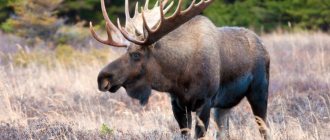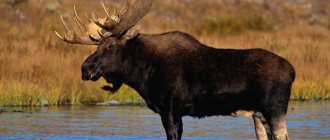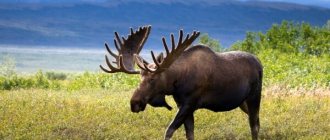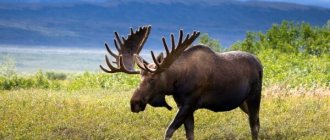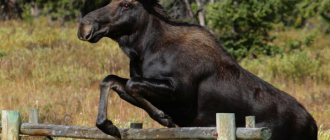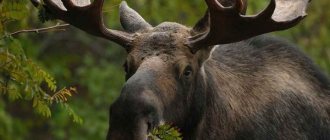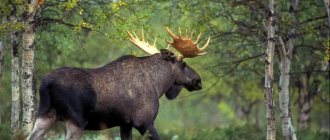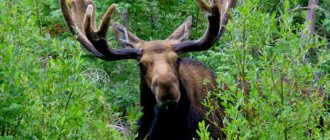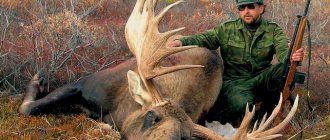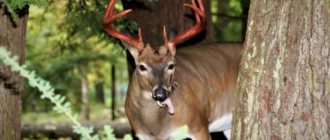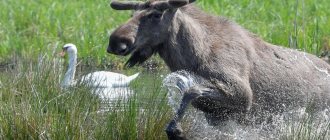Moose are large artiodactyl mammals from the deer family. The name of the animal comes from the ancient Slavic word ols, meaning “red-brown beast.” Moose are considered a valuable commercial artiodactyl species. Attempts to domesticate them for further use as mounts or for milk production ended in failure due to the complexity and cost of breeding.
According to the Ministry of Natural Resources and Ecology, the number of moose in Russia is about 1 million individuals. This is almost half of the total population of the species.
Origin of the species and description
Drawing of the animal Cervalces, which is supposedly a relative of the moose.
It is still unknown what animal the moose came from. The oldest remains found by humans date back to the early periods of the Pliocene (approximately 5 million years ago). Also during this time period lived the beast Cervalces, which looked like an elk. They could well have descended from a common ancestor.
It has been established that in Neolithic times, approximately 9,500 years ago, moose, similar in appearance to modern ones, inhabited the territories of Ukraine, Transcaucasia, England and the lands of Western Europe.
Currently the animal lives in America, Asia and northern Europe. At the beginning of the last century, the number of moose decreased, but people began to preserve the population in time. The measures taken allowed the animal to once again expand its habitat.
Hunting and fishing
Elk, or elk (Acles acles L.) is one of the largest representatives of artiodactyls and belongs to the deer family. He is the largest representative of our fauna. The body length of an adult male is 2.2-3 m, the height at the withers is 170-235 cm, the weight of males is from 300 to 650 kg, females are slightly less. The moose's head is long, massive, hook-nosed, the upper lip hangs over the lower. In young animals, a leathery outgrowth covered with long hair hangs from the chin - an “earring”. The male has spade-shaped horns on his head up to 1.5 m long and weighing up to 19 kg with short finger-like processes on the “blades”. Females are hornless. The body of the elk is covered with dark red coarse hair, long in winter (up to 10 cm) and short in summer (up to 5 cm). On the neck the hair is elongated, resembling a mane. The tail is short and inconspicuous. Moose is widespread in Eastern Europe and North America. Favorite habitats are the shores of forest lakes, swamps, forest clearings, places overgrown with aspen, willow and alder. Photo: Adult males live alone most of the year, while females and young moose live in groups of 5-6 animals. In winter, animals sometimes form herds of up to 10-15 animals. Elk has well-developed hearing and sense of smell, it is well adapted to life in swampy forests, swims well, and can stay in the water for a long time, escaping attacks from mosquitoes and midges. Narrow long legs allow you to move in water almost silently. The rut begins in the second half of August and lasts until the end of October. During this period, excited males dullly roar, “moo,” dig holes in the soil with their hooves, break tree branches with their horns—they let their rival know about their location and look for a meeting with the female. At such times, the elk loses its inherent caution, but it is better for a person not to catch its eye - it may attack first. During this period, moose hunting is possible. Pregnancy lasts 8-8.5 months. In May-June, the female gives birth to 1-2 calves weighing 9-16 kg, but if there are twins, then no more than 10 kg each. Young moose cows usually bear one calf. The milk is nutritious, contains up to 13% fat and the calves grow quickly. After only 4-5 days they can run after their mother, and at two weeks of age they keep up with the herd in running. However, they feed on mother’s milk for up to 3-4 months, after which they completely switch to pasture. After 6 months, the elk’s weight increases 10 times. In summer, moose feed mainly on grassy vegetation. They especially love succulent marsh plants: reeds, cattails, calamus, three-leafed water lilies, yellow water lilies (water lilies) and many others. In total, the animal consumes more than 250 species of plants, both higher (flowering) and lower (fungi, lichens). During the day, an elk eats 10-20 kg of tree, shrub and grass food. In winter, it eats shoots of willow, aspen, young pine, and juniper. In light frosts it can gnaw the bark of deciduous trees: aspen, willow, poplar, maple. A negative impact of moose on forest vegetation can occur only when the number exceeds 10 animals per 1000 hectares. At 12 years old, the moose begins to age. In the wild, there are very few moose over 10 years old - about 3%. In captivity they live up to 20 years or more. When do moose shed their antlers? At the end of the first or beginning of the second year of life, male elk calves develop pointed horns up to 30 cm long. The horns harden in July, and in August-September they are freed from the skin. Moose shed their antlers from leaf fall until early January. The following ones appear in forks, and spade-shaped ones develop only in the fifth year of life. In adulthood, elk have antlers with 8-10, and sometimes 11-12 tines. One- and two-year-old moose calves continue to walk with their mother, who drives them away only during mating. Sexual maturity is reached in the second year of life, but females mate only in the third autumn, and young males take part in the rut no earlier than 3-4 years. Full physical development occurs at 5 years of age. Old males lose their antlers at the end of the rut in November-January. New ones begin to grow in April-May for 2-2.5 months. They are covered with a velvety skin that peels off in August. To speed up this process, the elk rubs its antlers against tree trunks and branches. Hair shedding occurs once a year, in the spring, starting in March. The enemies of the moose are the wolf, the bear and the poacher, and the latter causes the greatest harm. An adult moose is a strong enough animal to fight off a wolf, but calves and young moose calves quite often become prey to predators. An adult animal can become a victim of predators only in winters with heavy snow. The elk's main weapon - his strong legs - get stuck in the snow and he cannot repel attacks. Moose often die when they fall into reclamation canals with steep slopes lined with concrete slabs, along which they cannot escape. In the summer, blood-sucking flies and gadflies are very annoying, and at night - mosquitoes and midges. Elk is a valuable game animal, its meat is nutritious and has a good taste, the skin is very durable and is used to make suede, belts and soles for sports shoes. The range and number of elk changes every 70-80 years, resembling the amplitude of inhalation and exhalation, that is, it expands and then contracts. Obviously we are now observing a period of decline (exhalation). Elk are easily tamed. Measures for its domestication are being successfully carried out in Russia (Pechora-Ilichsky Nature Reserve). Here they are trying to breed a special breed that, in the off-road conditions of the taiga, could carry loads and be suitable for riding and harnessing. During the lactation period, the female produces 200-400 liters of high-quality nutritious milk. Elk are unpretentious in keeping. For taming, newborn calves are caught, fed cow's milk for 3-4 months, and fed with fresh meadowsweet and other herbaceous plants. There should always be salt in the feeders. It is not recommended to feed moose calves bread and root vegetables. The kids learn to graze and return to the estate on their own in the evening. From the age of two months, elk calves are accustomed to harness and in the third year of life they are given a full load. An adult elk carries up to 500 kg of cargo in a sleigh, walking up to 30 km per day. They are also promising for use as pack and riding animals for hunting farms and expeditions in off-road conditions. Tamed moose reproduce well, and lactating females calmly respond to milking. Despite certain successes in taming the moose, work on its domestication has not yet left the experimental stage and has not become widespread. Or is a moose diving? Can moose dive? Or does it eat underwater vegetation? The question, despite its apparent simplicity, is not so easy to answer. It is common knowledge that moose, like wild reindeer, are good swimmers. In Yakutia, they freely swim across the Yana, Kolyma, and Lena in its middle part. There are periods when moose overcome water obstacles on a massive scale. Regarding the length of the swims, there is information in the literature that, for example, moose came to Kronstadt and its forts from 10-15 km away. At the Rybinsk Reservoir, they traveled up to 20 km by water. Approximately the same swim as the record was achieved for moose living in America. As for moose diving under water, as far as is known, there is still no completely established opinion on this issue. True, long ago, more than a hundred years ago, the famous naturalist A. Cherkasov wrote in “Notes of a Hunter of Eastern Siberia” that while swimming, moose “... press their ears tightly down and dive long distances under water.” But no actual observations have been made on this topic. And in the preface of this book (Chita 1958) there is a very specific editor’s note: “Moose do not dive, and especially not over long distances.” They can submerge their heads, receiving food from under the water, but in this case their ears remain, as a rule, outside." At the same time, American literature contains cases of moose diving to depths of up to 5 m (Peterson, 1955). In some cases, moose bathing and feeding in water becomes widespread. The small waves on the reaches subsided before midnight and the surface of the lake became mirror-like. It reflected light marble clouds, a red stripe of dawn on the horizon, and our kayak. Sometimes we scared flocks of ducks, but they landed on the lake again, flying to a safe distance. My companion went out onto the island, but immediately hurried back, pointing to the opposite shore, where some dark spot could be seen against the background of bushes. We swam closer and clearly saw a moose standing almost in the middle of the lake. Only his head and hump were visible. Judging by the massive horns, it was an old, large male. He swam, disappearing under water for 10-15 seconds so that even the tips of his horns were hidden. We approached it almost within a kayak oar's distance. The moose didn't just swim. Appearing on the surface, each time he chewed the algae that grew in abundance at the bottom of the reservoir. Based on materials:
Appearance and features
Close-up of a moose's hoof.
Moose are black and brown in color.
The coat is short, but there are noticeable extensions on the forehead and neck. The body is darker than the limbs. The latter have large narrow hooves with a point at the front. They are designed in such a way that when moving on grass and other soft surfaces, the body weight is distributed evenly. Interesting fact : the elk's head appears huge due to its nose, which is made of massive cartilage. It is oval in shape and blends smoothly into the upper lip.
Moose antlers close-up
The total length of both horns can reach 1.9 m, and the weight can be 45 kg. At the base they run in straight lines, but as they rise, numerous shoots appear. In the first year of life, individuals grow horns in thin stripes. Thanks to this, you can immediately determine its age. And only by five years, as they are renewed, their massiveness increases, and a large number of branches appear. Females do not have horns.
Adult moose grow up to 5.5 m in length, and their height sometimes reaches 2.5 m. The average weight of an individual is 650 kg. Males are larger than females. Despite its impressive dimensions, the animal is capable of moving quickly: its running speed can reach up to 40 km/h. Thanks to their strong hooves, moose confidently walk through dense forests, swamps and the foothills of mountains. They are excellent swimmers: if desired, the animal covers a distance of 3-5 km in water without much difficulty, and can also dive to great depths.
How much does it weigh
Elk is the largest representative of its family. The body of males reaches 3 m in length, while the height of the elk at the withers is 2-2.3 m. The weight of the animal depends on the habitat. Thus, the average weight of an adult moose is 400-600 kg, but individuals living in cold climatic zones have more impressive sizes. The largest representatives of the genus are found in Canada and the northern regions of Russia. The maximum documented weight of an elk is 820 kg. The male shot in the United States was a subspecies of Alaskan moose. Females are smaller in height and body weight.
Habitat - where moose live
Moose Habitat
Moose live in the Northern Hemisphere. Until the 19th century, its numerous populations were found in Europe, however, due to human activity, the animal almost completely disappeared from these lands. Only a century later, thanks to great efforts, it was possible to recreate conditions favorable for the spread of moose.
Interesting: Wild boar - description, range, lifestyle, habitat, food, enemies, reproduction, photos and videos
At the moment, the animal lives in Russia, Belarus, Ukraine, Poland, the Czech Republic, Hungary and other European countries. In the Russian Federation it is found from the southern steppes all the way to the Kola Peninsula. In Asia, elk inhabited Northern Mongolia, the northeastern territories of China and the Far East. In North America, the animal lives in the northeastern states, Canada and Alaska.
Moose prefer to live in coniferous forests
The natural environment for moose is considered to be coniferous forests located in swampy areas, near which streams flow. They are also found in the tundra, near the banks of rivers, lakes and other fresh water bodies. If there are mountains near the habitat, then in most cases the animal settles on plateaus, near slopes and in valleys.
Moose prefer to lead a sedentary lifestyle and do not travel long distances unless necessary. If there is enough food in the surrounding area, the animal is more likely to spend its entire life there.
The animal prefers to live alone, but can form herds in places where there is a large amount of food.
Interesting fact : on the territory of the Russian Federation, places where moose come in large numbers for food are called “camps”, and in Canada they are called “yards”.
Treasured trophy
Trees, bushes, and dense thorns are places where moose often shed their antlers. The reason is simple: artiodactyls look for a mate in the very area where they feed. At the same time, they rub their heads against trunks and thickets, which helps them get rid of the horns.
By the way, marks on plants left by animals are often found by hunters seeking the coveted trophy. Properly processed horns are used to make magnificent interior items (chandeliers, hangers and even furniture). They look aesthetically attractive and are valued like any handmade item.
Another interesting fact: it is often very difficult to find a whole pair of antlers in dense thickets or bodies of water. An elk can shed its second horn 10-15 kilometers from the place where the first one was shed.
And you don’t have to worry that the animal suffers when it sheds its antlers. The elk receives great relief, similar to what you experience when getting rid of excess weight. He does not feel any pain or discomfort.
What does it eat?
Moose eat plant foods.
The elk's diet consists exclusively of plant foods. It prefers leaves, shrubs, mushrooms, lichens and mosses. Depending on the time of year, the animal eats certain types of food.
In summer, the bulk of the diet consists of foliage, shrubs and plants growing near water bodies. A real delicacy is sedge. Among herbs, moose try to eat species that contain a large amount of moisture. In August, the animal, in addition to other food, eats mushrooms and berries. With the onset of autumn, it switches to tree branches and yellowed foliage, and in November it almost completely switches to bark.
In winter, moose eat raspberry bushes, as well as rowan, willow, fir and pine. If lichens are found on the territory, they are also eaten. If necessary, the animal is able to dig up snowdrifts and find food on the frozen ground.
Interesting fact : in winter, moose practically do not drink water, due to which they retain heat inside their bodies.
In the warm season, an adult eats 25-35 kg of food every day. In winter, the elk's appetite decreases significantly, and it requires only 11-14 kg. The animal's body needs a regular source of minerals, which is why they willingly drink salt water and lick rocks and soil.
Elk calves stay with their mother for up to one and a half years
After mating, males and females disperse until next year. Although they sometimes feed in the same areas, they tend to ignore each other.
In the spring, females give birth to one or two cubs, each weighing about 14 kg. Elk calves grow quickly and can exceed the size of a human by the age of five days. Young moose stay with their mothers until the next mating season because they cannot run fast and defend themselves from predators.
Photo: www.animalalliance.ca
Features of character and lifestyle
Moose bathes in water
In summer, moose try to stay in cool places. To escape the heat, they go neck-deep into water or lie on damp grass; in winter, they bury themselves in the snow, thus protecting themselves from frost.
Moose have poor eyesight, but perfect hearing. It is capable of detecting sounds at a distance of a kilometer. When it sees danger, the animal relies on its horns and its size, so it simply runs forward, hanging its head, regardless of where the enemy is.
Interesting: Deer - description, features, habitat, reproduction, species, nutrition, lifestyle, photos and videos
When eating food, the animal tries to spread its legs wide so that there is no need to tilt its head too much. Young individuals can even lie on their stomachs.
Even small organisms pose a threat to moose
Elk are a formidable opponent with sharp hooves and antlers, but even they have predators. A pack of wolves or a black bear will not be able to defeat an adult, so they usually hunt young, sick and old elk. But despite its power and enormous size, one bite from a predator can kill even a healthy moose: there is a high chance that the bite will cause an infection that will ultimately kill the animal within two weeks.
Moose also have a little enemy to worry about: parasites. Brainworm is a parasite that moose become infected with after eating snails. Infectious larvae migrate to the moose's brain and cause neurological damage. A parasite the size of a human hair can kill a 600-pound moose!
Another tiny nuisance is the winter tick. The likelihood of tick infestation depends on the weather and habitat: harsh winters lead to fewer ticks in the following year. So a frosty and long winter is great news for moose.
How does a moose spend the winter?
Elk in the winter forest
If in winter, in the territory where the elk lives, the height of the snowdrifts reaches more than 70 cm, then it moves to another place. Moreover, as a temporary home, the animal looks for coniferous forests with undergrowth, where snowdrifts are no higher than 35-50 cm. Several individuals can come to one territory in frosty times.
Having found a place favorable in terms of conditions, the elk waits out the winter, continuing to eat and lead its usual lifestyle. Females and their offspring are the first to leave for the winter, then males join them.
Interesting fact : moose go to winter in favorable places in October, and they can go to their destination until December, covering 15 km daily.
In a temporary place, the moose wait for the weather to warm up. When the snow begins to melt, the animals return to their original habitat, with adult males setting off first. Females and offspring set off on their journey after some time.
They are among the tallest land mammals
Moose are one of the largest and tallest representatives of land mammals in the world. They can reach 1.8 meters in height (from hoof to shoulder) and weigh more than 450 kg, according to the National Wildlife Federation. Alaskan moose is the largest subspecies. An adult male can reach 2.1 meters at the shoulder and weigh up to 720 kg. Females can weigh up to 585 kg.
Social structure and reproduction
Moose cow with cubs
Adult males prefer to live alone and join females only to create offspring. But the latter often unite in small groups in winter, raising their young together.
The mating season for moose begins in late summer. Males make characteristic sounds when chasing a female. They also hit the ground with their hoofs and break tree branches with their horns to attract attention. During this period, males spend time with only one female, but if she does not reciprocate, they may go in search of another. Pregnancy lasts on average 230 days. A maximum of two cubs appear at a time; they weigh 7-14 kg.
Interesting fact : when a calf is born, it immediately tries to get up, but in most cases it falls to the ground, because his limbs were not yet strong.
Calves develop quite quickly. On the second day they can move, and on the fifth they are able to run. Two weeks after birth, the cubs already try grass, but do not stop feeding on milk for four months.
Males lose and grow antlers every year
The males' horns extend almost 1.8 meters from tip to tip. Moose shed and regrow their antlers every year. Antlers are a sign of dominance and help males protect their eyes when fighting other moose. They sometimes spray urine on their antlers to lure females to mate.
The horns have a bony base and are covered with soft skin called velvet. They develop quickly, growing up to 20 cm in nine days. Before the mating season in September, males experience a surge of testosterone, which causes the velvet to molt and the antlers to become bare.
What is the difference between elk and deer?
A deer is easily recognized by its antlers that grow vertically.
Despite the fact that both animals are representatives of the same family, they have a number of certain differences. Moose are much larger in size, and their antlers grow horizontally. In deer, the latter rise upward. Moose limbs are thinner and shorter. Deer are also lighter in color.
Interesting: Wolf
